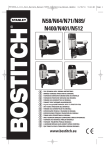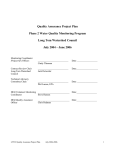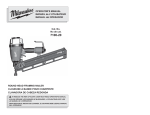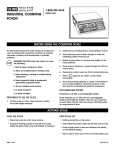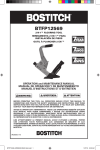Download U-Line H-3071 Specifications
Transcript
π H-3071
NAIL GUN
1-800-295-5510
uline.com
BOSTITCH
INSTRUCTIONS
SAFETY INSTRUCTIONS
WARNING! EYE PROTECTION which conforms to
ANSI specifications and provides protection
against flying particles both from the FRONT
and SIDE should ALWAYS be worn by the
operator and others in the work area when
connecting to air supply, loading, operating
or servicing this tool. Eye protection is required
to guard against flying fasteners and debris
which could cause severe eye injury.
The employer and/or user must ensure that
proper eye protection is worn. Eye protection
equipment must conform to the requirements
of the American National Standards Institute,
ANSI Z87.1, and provide both frontal and side
protection.
NOTE: Non-side shielded spectacles and
face shields alone do not provide adequate
protection.
CAUTION: Additional safety protection will be
required in some environments. For example,
the working area may include exposure to
noise level which can lead to hearing damage.
The employer and user must ensure that any
necessary hearing protection is provided and
used by the operator and others in the work
area. Some environments will require the use
of head protection equipment. When required,
the employer and user must ensure that head
protection conforming to ANSI Z89.1 is used.
PAGE 1 OF 9
AIR SUPPLY AND CONNECTIONS
WARNING! Do not use oxygen, combustible
gases or bottled gases as a power source for
this tool, as tool may explode, possibly causing
injury.
WARNING! Do not use supply sources which
can potentially exceed 200 psig as tool may
burst, possibly causing injury.
WARNING! The connector on the tool must not
hold pressure when air supply is disconnected.
If a wrong fitting is used, the tool can remain
charged with air after disconnecting and thus
will be able to drive a fastener even after the
air line is disconnected, possibly causing injury.
WARNING! Do not pull trigger or depress
contact arm while connected to the air supply
as the tool may cycle, possibly causing injury.
WARNING! Always disconnect air supply:
1) Before making adjustments; 2) When
servicing the tool; 3) When clearing a jam;
4) When tool is not in use; 5) When moving to
a different work area, as accidental actuation
may occur, possibly causing injury.
LOADING TOOL
WARNING! When loading tool: 1) Never place a
hand or any part of body in fastener discharge
area of tool; 2) Never point tool at anyone;
3) Do not pull the trigger or depress the trip
as accidental actuation may occur, possibly
causing injury.
0512 IH-3071
INSTRUCTIONS CONTINUED
OPERATION
WARNING! Always handle the tool with care:
1) Never engage in horseplay; 2) Never pull
the trigger unless nose is directed toward the
work; 3) Keep others a safe distance from the
tool while tool is in operation as accidental
actuation may occur, possibly causing injury.
WARNING! The operator must not hold the
trigger pulled on contact arm tools except
during fastening operation as serious injury could
result if the trip accidentally contacted someone
or something, causing the tool to cycle.
WARNING! Keep hands and body away from
the discharge area of the tool. A contact arm
tool may bounce from the recoil of driving a
fastener and an unwanted second fastener
may be driven, possibly causing injury.
WARNING! Check operation of the contact arm
mechanism frequently. Do not use the tool if
the arm is not working correctly as accidental
driving of a fastener may result. Do not interfere
with the proper operation of the contact arm
mechanism.
WARNING! Do not drive fasteners on top of
other fasteners or with the tool at an overly
steep angle as this may cause deflection of
fasteners which could cause injury.
WARNING! Do not drive fasteners close to the
edge of the work piece as the wood may split,
allowing the fastener to be deflected, possibly
causing injury.
WARNING! This nailer produces SPARKS
during operation. NEVER use the nailer near
flammable substances, gases or vapors
including lacquer, paint, benzene, thinner,
gasoline, adhesives, mastics, glues or any
other material that is -- or the vapors, fumes
or by products of which are -- flammable,
combustible or explosive. Using the nailer
in any such environment could cause an
EXPLOSION resulting in personal injury or death
to user and bystanders.
WARNING! Never use rafter hook to hang tool
from body, clothing or belt.
MAINTAINING THE TOOL
WARNING! When working on air tools note the
warnings in this manual and use extra care
when evaluating problem tools.
TOOL SPECIFICATIONS
All screws and nuts are metric.
MODEL
TOOL ACTUATION
N89C-1
Contact Trip
(with sequential trip option)
LENGTH.
HEIGHT
WIDTH
WEIGHT
12¼" (311 mm)
14" (355 mm)
5¼" (133.4mm)
8.2 lb (3.7 kg)
FASTENER SPECIFICATIONS
OPERATING PRESSURE
The N89C tools uses wire collated coil nails in lengths
of 2" to 3½" (50 - 90mm) with shank diameters of .099" .131" (2.5 - 3.3mm)
70 to 120 psig (4.8 to 8.3 kg/cm2). Select the operating
pressure within this range for best fastener performance.
TOOL AIR FITTING
This tool uses a free-flow connector plug, ¼" N.P.T. The
minimum inside diameter should be .275" (7mm). The
fitting must be capable of discharging tool air pressure
when disconnected from the air supply.
PAGE 2 OF 9
WARNING! Do not exceed the recommended
operating pressure.
AIR CONSUMPTION
The N89C requires 8.23 cubic feet per minute (233 liters
per minute) of free air to operate at the rate of 100 nails
per minute, at 80 p.s.i. (5.6 kg/cm2). Take the actual rate at
which the tool will be run to determine the amount of air
required. For instance, if your fastener usage averages 50
nails per minute, you need 50% of the 8.23 c.f.m. (233 liters
per minute) which is required to operate the tool at 100
nails per minute.
0512 IH-3071
INSTRUCTIONS CONTINUED
MODES OF OPERATION
SUPPLY SOURCE
BOSTITCH OFFERS TWO MODES OF OPERATION FOR
THIS SERIES TOOL.
Use only clean regulated compressed air as a power
source for this tool. NEVER USE OXYGEN, COMBUSTIBLE
GASES OR BOTTLED GASES AS A POWER SOURCE FOR THIS
TOOL AS TOOL MAY EXPLODE.
SEQUENTIAL TRIP (Gray trigger)
The Sequential Trip requires the operator
to hold the tool against the work surface
before pulling the trigger. This makes
accurate fastener placement easier on framing, toe
nailing and crating applications. The Sequential
Trip allows exact fastener placement without the
possibility of driving a second fastener on recoil, as
described under "Contact Trip". The Sequential Trip
Tool has a positive safety advantage because it will
not accidentally drive a second fastener if the tool is
contacted against the work – or anything else – while
the operator is holding the trigger pulled.
CONTACT TRIP (Black trigger)
The common operating procedure on
Contact Trip tools is for the operator to
contact the work surface to actuate the trip
mechanism while keeping the trigger pulled, thus
driving a fastener each time the work is contacted.
This will allow rapid fastener placement on many jobs
such as sheathing, decking and pallet assembly. All
pneumatic tools are subject to recoil when driving
fasteners. The tool may bounce releasing the trip and,
if unintentionally allowed to, re-contact the work surface
with the trigger still actuated (finger still holding trigger
pulled). An unwanted second fastener will be driven.
MODEL IDENTIFICATION
Refer to Operation Instructions on page 5 before
proceeding to use this tool.
AIR SUPPLY AND CONNECTIONS
WARNING! Do not use oxygen, combustible
gases or bottled gases as a power source for this
tool as tool may explode, possibly causing injury.
FITTINGS
Install a male plug on the tool which is free flowing
and which will release air pressure from the tool when
disconnected from the supply source.
HOSES
Air hoses should have a minimum of 150 psi (10.6 kg/
cm2) working pressure rating or 150 percent of the maximum pressure that could be produced in the air system.
The supply hose should contain a fitting that will provide
"quick disconnecting" from the male plug on the tool.
PAGE 3 OF 9
REGULATOR
A pressure regulator with an operating pressure of
0 - 125 psi (0 - 8.79 kg/cm2) is required to control the
operating pressure for safe operation of this tool. Do not
connect this tool to air pressure which can potentially
exceed 200 psi (14 kg/cm2) as tool may fracture or burst,
possibly causing injury.
OPERATING PRESSURE
Do not exceed recommended maximum operating
pressure as tool wear will be greatly increased. The air
supply must be capable of maintaining the operating
pressure at the tool. Pressure drops in the air supply
can reduce the tool’s driving power. Refer to "TOOL
SPECIFICATIONS" for setting the correct operating
pressure for the tool.
FILTER
Dirt and water in the air supply are major causes of
wear in pneumatic tools. A filter will help to get the
best performance and minimum wear from the tool.
The filter must have adequate flow capacity for the
specific installation. The filter has to be kept clean to
be effective in providing clean compressed air to the
tool. Consult the manufacturer's instructions on proper
maintenance of your filter. A dirty and clogged filter
will cause a pressure drop which will reduce the tool’s
performance.
LUBRICATION
Frequent, but not excessive, lubrication is required
for best performance. Oil added through the air line
connection will lubricate the internal parts. Use BOSTITCH
air tool lubricant (included), Mobil Velocite #10 or
equivalent. Do not use detergent oil or additives as
these lubricants will cause accelerated wear to the
seals and bumpers in the tool, resulting in poor tool
performance and frequent tool maintenance.
If no air line lubricator is used, add oil during use into
the air fitting on the tool once or twice a day. Only a
few drops of oil at a time is necessary. Too much oil will
only collect inside the tool and will be noticeable in the
exhaust cycle.
0512 IH-3071
INSTRUCTIONS CONTINUED
LUBRICATION CONTINUED
COLD WEATHER OPERATION
For cold weather operation near and below freezing,
the moisture in the air line may freeze and prevent tool
operation. We recommend the use of BOSTITCH winter
formula air tool lubricant (included) or permanent
antifreeze (ethylene glycol) as a cold weather lubricant.
CAUTION: Do not store tools in a cold weather
environment in order to prevent frost or ice
formation on the tool's operating valves and
mechanisms that could cause tool failure.
NOTE: Some commercial air line drying liquids
are harmful to O-rings and seals – do not
use these low temperature air dryers without
checking compatibility.
LOADING
CAUTION: EYE PROTECTION which conforms to
ANSI specifications and provides protection
against flying particles both from the FRONT
and SIDE should ALWAYS be worn by the
operator and others in the work area when
connecting to air supply, loading, operating
or servicing this tool. Eye protection is required
to guard against flying fasteners and debris
which could cause severe eye injury.
The employer and/or user must ensure that
proper eye protection is worn. Eye protection
equipment must conform to the requirements
of the American National Standards Institute,
ANSI Z87.1 and provide both frontal and side
protection.
NOTE: Non-side shielded spectacles and
face shields alone do not provide adequate
protection.
TO PREVENT ACCIDENTAL INJURIES
•Never place a hand or any other part of the
body in nail discharge area of tool while the
air supply is connected.
•Never point the tool at anyone else.
•Never engage in horseplay.
1. Open the canister: Pull down
door latch and swing door/
canister cover outward.
(See Figure 1)
2. Check Adjustment: The nailer
must be set for the length of
nail to be used. Nails will not
feed smoothly if the canister
is not correctly adjusted. The
canister contains an adjustable
nail platform on which the nail
coil rests. The nail platform can
be moved up and down to four
nail settings. To change setting
pull up on the post and twist to
the correct step. (See Figure 2)
Figure 1
Figure 2
PLATFORM SETTINGS
• 1st Step: 2" – 2½" (50 - 65mm) nails
• 2nd Step: 2¾" – 3" (70 - 75mm) nails
• 3rd Step: 3¼" – 3½" (80 - 90mm) nails
3. Load the coil of nails: Place
the coil of nails over the post
in the canister. Uncoil enough
nails to reach the feed pawl.
Place the first nail in front of the
front tooth on the feed pawl
in the driver channel. The nail
heads must be in the slot in the
nose. (See Figure 3)
Figure 3
NOTE: Use only nails recommended by
BOSTITCH for N89C series nailers or nails which
meet BOSTITCH specifications.
4. Swing cover closed.
5. Close the door: Check that latch engages.
(If it does not engage, check that the nail heads
are in the slot on the nose.)
FASTENER DEPTH CONTROL ADJUSTMENT
The Fastener Depth Control Adjustment feature on this
tool provides control of the nail drive depth from flush
with or just above the work surface to shallow or deep
countersink.
•Never pull the trigger unless nose is directed
at the work.
•Always handle the tool with care.
•Do not pull the trigger or depress the trip
mechanism while loading the tool.
PAGE 4 OF 9
0512 IH-3071
INSTRUCTIONS CONTINUED
FASTENER DEPTH CONTROL ADJUSTMENT
CONTINUED
TO ADJUST THE FASTENER DEPTH CONTROL
WARNING! Disconnect tool from air supply
before attempting any parts disassembly and
before changing the work contacting element
adjustment.
1. Push in on locking button.
2. Adjust contact arm up to increase depth
of drive or down to decrease it.
3. Release locking button. (See Figure 1)
connecting to air supply, loading, operating
or servicing this tool. Eye protection is required
to guard against flying fasteners and debris,
which could cause severe eye injury.
The employer and/or user must ensure that
proper eye protection is worn. Eye protection
equipment must conform to the requirements
of the American National Standards Institute,
ANSI Z87.1 and provide both frontal and side
protection.
NOTE: Non-side shielded spectacles and
face shields alone do not provide adequate
protection.
BEFORE HANDLING OR OPERATING THIS TOOL
I. READ AND UNDERSTAND THE WARNINGS
CONTAINED IN THIS MANUAL.
II. REFER TO "TOOL SPECIFICATIONS" IN THIS
MANUAL TO IDENTIFY THE OPERATING SYSTEM
ON YOUR TOOL.
LOCKING BUTTON
CONTACT ARM
1. PUSH IN
3. RELEASE
Figure 1
2. ADJUST
There are two available operation modes on these
BOSTITCH pneumatic tools. They are:
1. SEQUENTIAL TRIP OPERATION
2. CONTACT TRIP OPERATION
DIRECTIONAL EXHAUST DEFLECTOR
OPERATION
The adjustable exhaust deflector can be rotated into
any desired position by hand without the use of any
tools. (See Figure 2)
BOSTITCH offers two types of triggers for pneumatic tools:
Sequential Trip (gray trigger) and Contact Trip (black
trigger). Each trigger has specific advantages. You
should evaluate your particular construction project to
determine which trigger is best.
Figure 2
EXHAUST DEFLECTOR
Your tool was shipped from the factory in the Sequential
Trip (gray trigger) configuration. It can easily be
converted to the Contact Trip (black trigger) mode of
operation.
1. SEQUENTIAL TRIP OPERATION (GRAY TRIGGER)
TOOL OPERATION
WARNING! EYE PROTECTION which conforms to
ANSI specifications and provides protection
against flying particles both from the FRONT
and SIDE should ALWAYS be worn by the
operator and others in the work area when
PAGE 5 OF 9
The Sequential Trip (gray trigger) gets its name from
the "sequence" required to drive a fastener. To drive a
fastener, the operator must first depress the "trip" FULLY
against the work surface and then pull the trigger. To
drive a second nail, the operator must lift the tool from
the work surface, release the trigger and then repeat
the above sequence.
a. The Sequential Trip (gray trigger) offers a positive
safety advantage since it will not accidentally
drive a fastener if the tool is bumped against any
surface or anybody while the operator is holding
the tool with the trigger pulled.
0512 IH-3071
INSTRUCTIONS CONTINUED
TOOL OPERATION CONTINUED
b. The Sequential Trip (gray trigger) allows "place
nailing" without the possibility of driving a
second, unwanted fastener on recoil as
described below under "Contact Trip".
2. CONTACT TRIP (CONVENTIONAL) OPERATION
(BLACK TRIGGER)
Your new BOSTITCH tool can be configured for use in
Contact Trip mode. To drive a nail, the "trip" and the
trigger must both be depressed. In Contact Trip tools,
the trigger may be depressed and held, and each
"contact" between the trip and the work surface will drive
a nail.
a. SINGLE FASTENER PLACEMENT (Place Nailing) –
First position the "trip" FULLY on the work surface
WITHOUT PULLING THE TRIGGER. Depress the "trip"
FULLY until the nose of the tool touches the work
surface and then pull the trigger to drive a nail.
Do not press the tool against the work surface
with extra force. Instead, allow the tool to recoil
off the work surface to avoid a second unwanted
fastener.
NOTE: Remove your finger from the trigger after
each operation.
b. RAPID FIRE OPERATION ("Bump" Nailing) – First,
hold the tool with the "trip" pointing towards but
not touching the work surface. Pull the trigger
and then tap or "bump" the trip against the work
surface using a bouncing motion. Each depression
of the "trip" will cause a nail to be driven.
WARNING! The Contact Trip (black) will not
prevent a nail from being accidently driven
if the trigger is depressed and the "trip" is
bumped against any object or person. Never
hold or carry the tool with your finger on the
trigger. Only depress and hold trigger when
you intend to rapidly drive multiple nails and
the tool is pointed at the work surface.
WARNING! Never use contact trigger (black
trigger) with metal connector attachment.
Only use sequential trigger (grey trigger) with
metal connector attachment. Refer to trigger
conversion instruction included in the kit.
WARNING! When using conventional Contact
Trip for Place Nailing, the tool may bounce due
to recoil and if the tool is allowed to re-contact
the work surface while you are holding the
trigger pulled, a second unwanted nail will be
driven. You should allow the tool to recoil far
PAGE 6 OF 9
enough to release the trip and avoid a second
cycle. Don’t push the tool down extra hard; let
the tool do the work.
WARNING! The operator must not hold the
trigger pulled on contact trip tools, except
during fastening operation, as serious injury
could result if the trip accidentally contacted
someone or something, causing the tool to
cycle.
WARNING! Keep hands and body away from
the discharge area of the tool. A contact trip
tool may bounce from the recoil of driving a
fastener and an unwanted second fastener
may be driven, possibly causing injury.
WARNING! Never use rafter hook to hang tool
from body, clothing or belt.
TOOL OPERATION CHECK
CAUTION: Remove all fasteners from tool before
performing tool operation check.
1. SEQUENTIAL TRIP OPERATION
a. Press the contact trip against the work surface
without touching the trigger.
THE TOOL MUST NOT CYCLE.
b. Hold the tool off the work surface and pull the
trigger. THE TOOL MUST NOT CYCLE. Release the
trigger. The trigger must return to the trigger stop
on the frame.
c. Pull the trigger and press the contact trip against
the work surface.
THE TOOL MUST NOT CYCLE.
d. With finger off the trigger, press the contact trip
against the work surface. Pull the trigger.
THE TOOL MUST CYCLE.
2. CONTACT TRIP OPERATION
a. With finger off the trigger, press the contact trip
against the work surface.
THE TOOL MUST NOT CYCLE.
b. Hold the tool off the work surface and pull the
trigger. THE TOOL MUST NOT CYCLE.
c. With the tool off the work surface, pull the trigger.
Press the contact trip against the work surface.
THE TOOL MUST CYCLE.
d. Without touching the trigger, press the contact
trip against the work surface, then pull the trigger.
THE TOOL MUST CYCLE.
0512 IH-3071
INSTRUCTIONS CONTINUED
TOOL OPERATION CHECK CONTINUED
MAINTAINING THE PNEUMATIC TOOL
WARNING! When working on air tools, note the
warnings in this manual and use extra care
evaluating problem tools.
IN ADDITION TO THE OTHER WARNINGS
CONTAINED IN THIS MANUAL OBSERVE THE
FOLLOWING FOR SAFE OPERATION
REPLACEMENT PARTS
• Use the BOSTITCH pneumatic tool only for the
purpose for which it was designed.
• Never use this tool in a manner that could cause a
fastener to be directed toward the user or others in
the work area.
• Do not use the tool as a hammer.
• Always carry the tool by the handle. Never carry the
tool by the air hose.
• Do not alter or modify this tool from the original
design or function without approval from BOSTITCH.
• Always be aware that misuse and improper handling
of this tool can cause injury to yourself and others.
• Never clamp or tape the trigger or contact trip in an
actuated position.
• Never leave a tool unattended with the air hose
attached.
• Do not operate this tool if it does not contain a
legible WARNING LABEL.
• Do not continue to use a tool that leaks air or does
not function properly. Contact ULINE Customer
Service at 1-800-295-5510 if your tool continues to
experience functional problems.
BOSTITCH replacement parts are recommended. Do
not use modified parts or parts which will not give
equivalent performance to the original equipment.
ASSEMBLY PROCEDURE FOR SEALS
When repairing a tool, make sure the internal parts are
clean and lubricated. Use Parker O-LUBE or equivalent
on all O-rings. Coat each O-ring with O-LUBE before
assembling. Use a small amount of oil on all moving
surfaces and pivots. After reassembly add a few drops
of BOSTITCH Air Tool Lubricant through the air line fitting
before testing.
AIR SUPPLY PRESSURE AND VOLUME
Air volume is as important as air pressure. The air volume
supplied to the tool may be inadequate because of
undersize fittings and hoses or from the effects of dirt
and water in the system. Restricted air flow will prevent
the tool from receiving an adequate volume of air even
though the pressure reading is high. The results will be
slow operation, misfeeds or reduced driving power.
Before evaluating tool problems for these symptoms,
trace the air supply from the tool to the supply source
for restrictive connectors, swivel fittings, low points
containing water and anything else that would prevent
full volume flow of air to the tool.
Troubleshooting
Operating Issue
Trigger valve stem leaks air
Frame/nose leaks air
Frame/cap leaks air
PAGE 7 OF 9
CAUSE
CORRECTION
O-ring cut or cracked
Replace O-ring
O-ring/seals cut or cracked
Replace trigger valve assembly
Loose nose screws
Tighten and recheck
O-ring or gasket is cut or cracked
Replace O-ring or gasket
Bumper cracked/worn
Replace bumper
Damaged gasket or seal
Replace gasket or seal
Cracked/worn head valve bumper
Replace bumper
Loose cap screws
Tighten and recheck
0512 IH-3071
Troubleshooting CONTINUED
Operating Issue
Failure to cycle
Lack of power; slow to cycle
Skipping fasteners;
intermittent feed
Fasteners jam in tool
PAGE 8 OF 9
CAUSE
CORRECTION
Air supply restriction
Check air supply equipment
Tool dry, lack of lubrication
Use BOSTITCH Air Tool Lubricant
Worn head valve O-rings
Replace O-rings
Broken cylinder cap spring
Replace cylinder cap spring
Tool dry, lacks lubrication
Use BOSTITCH Air Tool Lubricant
Broken cylinder cap spring
Replace cap spring
O-rings/seals cut or cracked
Replace O-rings/seals
Exhaust blocked
Check bumper, head valve spring, muffler
Trigger assembly worn/leaks
Replace trigger assembly
Dirt/tar buildup on driver
Disassemble nose/driver to clean
Cylinder sleeve not seated correctly
on bottom bumper
Disassemble to correct
Head valve dry
Disassemble/lubricate
Air pressure too low
Check air supply equipment
Worn bumper
Replace bumper
Tar/dirt in driver channel
Disassemble and clean nose and driver
Air restriction/inadequate air flow through
quick disconnect socket and plug
Replace quick disconnect fittings
Worn piston O-ring
Replace O-ring, check driver
Tool dry, lacks lubrication
Use BOSTITCH Air Tool Lubricant
Damaged feed piston spring
Replace spring
Low air pressure
Check air supply system to tool
Loose canister nose screws
Tighten all screws
Fasteners too short for tool
Use only recommended fasteners
Bent fasteners
Discontinue using these fasteners
Wrong size fasteners
Use only recommended fasteners
Leaking head cap gasket
Tighten screws/replace gasket
Trigger valve O-ring cut/worn
Replace O-ring
Broken/chipped driver
Replace driver (check piston O-ring)
Dry/dirty magazine
Clean/lubricate use BOSTITCH Air Tool Lubricant
Driver channel worn
Replace nose/check door
Wrong size fasteners
Use only recommended fasteners
Bent fasteners
Discontinue using these fasteners
Loose canister/nose screws
Tighten all screws
Broken/chipped driver
Replace driver
0512 IH-3071
Troubleshooting CONTINUED
COIL NAILERS
Operating Issue
Skipping fasteners;
intermittent feed
Fasteners jam in tool/canister
CAUSE
CORRECTION
Feed piston dry
Add BOSTITCH Air Tool Lubricant in hole in
feed piston cover
Feed piston O-rings cracked/worn
Replace O-rings/check bumper and spring.
Lubricate assembly
Check pawl binding
Inspect pawl and spring on door
Must work freely
Canister bottom not set correctly
Set canister bottom for length of nails
being used
Broken weld wires in nail coil
Remove coil of nails and use another coil
Wrong size fasteners for tool
Use only recommended fasteners/check
canister bottom adjustment
Broken welded wires in nail coil
Remove coil of nails and use another coil
Wrong slide plate adjustment for
wire collated nail coil
Adjust switch pins for wire collated nail coil
π CHICAGO • ATLANTA • DALLAS • LOS ANGELES • MINNEAPOLIS • NYC/PHILA • SEATTLE • MEXICO • CANADA
1-800-295-5510
PAGE 9 OF 9
uline.com
0512 IH-3071









